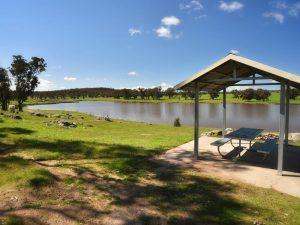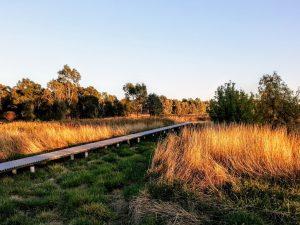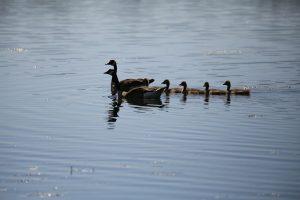- Home
- Council
- Regulatory Control
- Services
- Projects
- Your Community
- Investment
- Phone: 02 6924 8100
- Home
- Council
- Regulatory Control
- Services
- Projects
- Your Community
- Investment
Bethungra Dam
 Originally constructed in 1895 as a water supply dam to service Junee, this dam is located in the north east sector of Junee Shire, just north of Ulandra Nature Reserve. It continued to be used as a public water supply until about 1906, when water quality problems led to its disuse.
Originally constructed in 1895 as a water supply dam to service Junee, this dam is located in the north east sector of Junee Shire, just north of Ulandra Nature Reserve. It continued to be used as a public water supply until about 1906, when water quality problems led to its disuse.
The dam covers an area of 14.65 hectares and holds 600 megalitres of water. It is on Crown Land and is managed by Junee Shire Council. Much of the land surrounding the dam is privately owned, while the remainder is leased for agricultural purposes.
In 1993, the first formally identified blue green algae bloom was recorded in the dam. This led to its closure for recreational purposes. In 2000 a small outbreak of blue green algae was recorded in the Dam. Several fish perished in this event and once again all recreation activities were forced to cease. One possible theory for the blue green algae blooms in the dam is the likely run-off of excess phosphates and nitrates from pasture and crop fertilisation. These compounds, particularly phosphates, build up in the soil over a period of decades until they reach a critical point after which the soil can no longer retain them. They are then leached out in run-off, to watercourses and the dam.
The “Bethungra Reserve Plan of Management”, 1989 lists flora and fauna observed or expected to occur on Bethungra Reserve.
 The electrical fit out and installation of feature lights were the last stages in the construction of the jetty on Park Dam.
The electrical fit out and installation of feature lights were the last stages in the construction of the jetty on Park Dam.
Its completion represents one of the last pieces of the jigsaw in the revitalisation of Park Dam; a project that commenced following concerns about the stability of the Council’s pump shed after European Carp had eroded the bank beneath it.
Along with the de-silting and bank stabilisation works, the construction of the jetty has vastly improved the amenity of the area and, following the completion of the landscaping and path extension, it will also provide a much more accessible and safe facility for the young, infirm and disabled.
Anglers young and old will also be delighted to hear that along with a terrific new fishing platform, Fisheries NSW will also be conducting annual stocking of Murray cod and golden perch at Park Dam. Anglers are reminded that all the regulations for recreational fishing in enclosed waters apply and Fisheries Officers may conduct spot checks to ensure compliance with the regulations. For information about recreational fishing licences and regulations, visit http://www.dpi.nsw.gov.au/fisheries/recreational/regulations
Park Dam is now on the State stocking register which means we should see an annual top-up of both Murray Cod and Golden Perch (aka Yellow Belly) by the Department of Primary Industries.
Just under 3000 Murray Cod were released into the dam, with a similar number of Golden Perch released in mid to late March 2013.
 The Junee Wetland is home to a variety of plant and animal species. It is rich in biodiversity, and plays an integral part in urban stormwater management, receiving almost 75% of the town’s stormwater runoff.
The Junee Wetland is home to a variety of plant and animal species. It is rich in biodiversity, and plays an integral part in urban stormwater management, receiving almost 75% of the town’s stormwater runoff.
The plant species existing in the wetland are indicative of salinised areas. They are also vitally important to the health of the ecosystem, helping to slow water flow through the wetland and take up excess nutrients from polluted water.
The wetland provides food, water, shelter, breeding sites and foraging areas for many different animals including birds, reptiles, amphibians, mammals, fish, insects and many other invertebrates.
Our wetland should be conserved as a valuable asset to the community. It is a place of interest for community members as well as visitors to the area.
The Junee Wetland has evolved over many years with Council, Landcare and interested community members working together to enhance the amenity, and conservation value of the area.
Projects already completed include the construction of a series of boardwalks incorporating a viewing platform, planting of native tree and shrub species, weed control and a boardwalk upgrade to make the main thoroughfare wider with concrete paths leading up to the boardwalk.
Download: Birds at the Junee Urban Wetland
 In 1997 a 140ML storage dam was constructed at the Junee Sewage Treatment Plant, for the storage of effluent to be reused for irrigation of the Golf Course and Junee High School grounds.
In 1997 a 140ML storage dam was constructed at the Junee Sewage Treatment Plant, for the storage of effluent to be reused for irrigation of the Golf Course and Junee High School grounds.
The pond has become home to a wide variety of native wildlife including Short and Long Necked Turtles, Pied Stilts, Terns, various species of duck and a large colony of Black Swans. Council has liaised with NSW Fisheries and introduced Silver Perch and Cod into the storage pond in a move to increase biodiversity.
In June 2002, a group of volunteers from Conservation Volunteers Australia carried out a week long project aimed at protecting and enhancing the native flora and fauna present at the Treatment Plant. The project involved planting a mix of 200 trees and shrubs, building nesting boxes, a fox proof fence and a floating pontoon. Council supplied all materials in an effort to provide safe nesting habitat for some species of ducks and swans and to protect turtle eggs from being predated by foxes.
During the drought, the storage pond dried out significantly. While this was not an ideal situation for wildlife living there, it did give Council a chance to build up the island in the middle of the pond. This island is a refuge for many bird species and turtles too. During winter months when reuse is typically low, the pond would become submerged making it inaccessible to wildlife. So when the drought had dried up the pond, Council was able to access the island. Loads of soil were carted out to build up the height of the island, trees were planted and hollow logs were placed out there for habitat. The end result has seen an increase in the amount of wildlife seen at the pond.
Download: Birds at the Effluent Reuse Dam